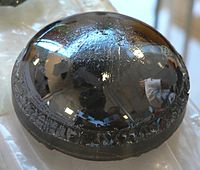
Photo from wikipedia
Mild steel panels were subjected to zinc phosphate conversion coating accelerated by environment friendly nano silicon dioxide using a series of cationic surfactants as additives. Four cationic surfactants have been… Click to show full abstract
Mild steel panels were subjected to zinc phosphate conversion coating accelerated by environment friendly nano silicon dioxide using a series of cationic surfactants as additives. Four cationic surfactants have been synthesized in the absence of solvent using triethylamine and four different long chain alkyl halides. From 1H NMR and 13C NMR spectra the chemical structures of the synthesized surfactants were confirmed. The nano silicon dioxide accelerator provided a highly porous phosphate coating ensuring good adhesion to the consecutive top coating. The incorporation of cationic surfactants as additives led to fine-grained coatings which enhanced adherence and excellent corrosion resistance property to the phosphate coating. The performance of the surfactants as a corrosion inhibitor increases with the increase in the hydrophobicity of the side-chain length. Accelerator and additive incorporation effectively reduced the extent of zinc dissolution during phosphating and exhibited the highest polarization resistance. The good dispersability of additives and increased hydrophobicity yielded coatings with improved protection against corrosion. The corrosion inhibition performance of the coated steel has been studied by Open Circuit Potential (OCP), Potentiodynamic Polarization Curve, Electrochemical Impedance Spectroscopy (EIS) and salt spray test.
Journal Title: Silicon
Year Published: 2017
Link to full text (if available)
Share on Social Media: Sign Up to like & get
recommendations!